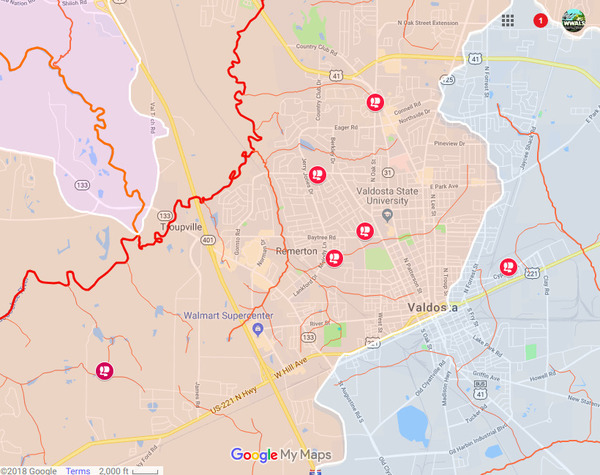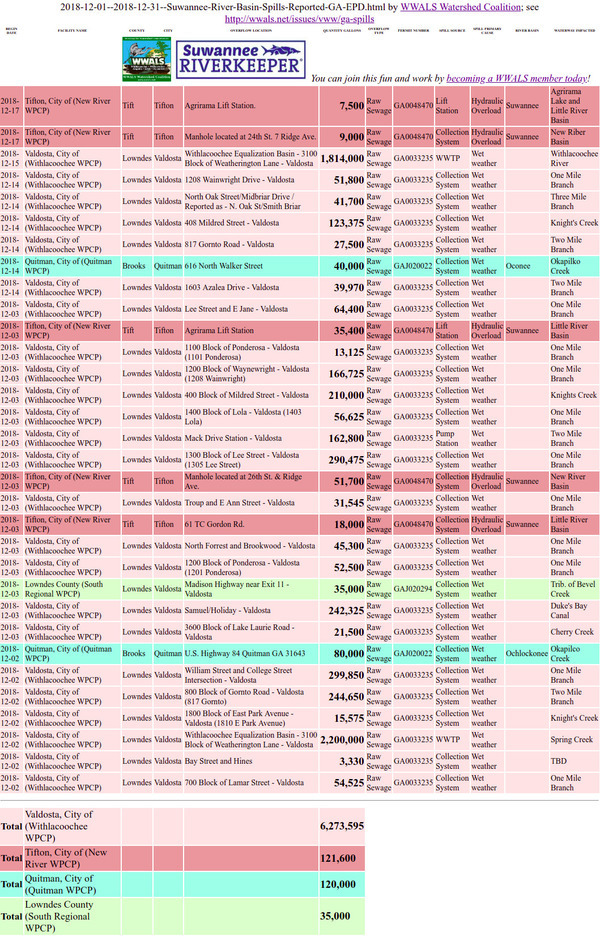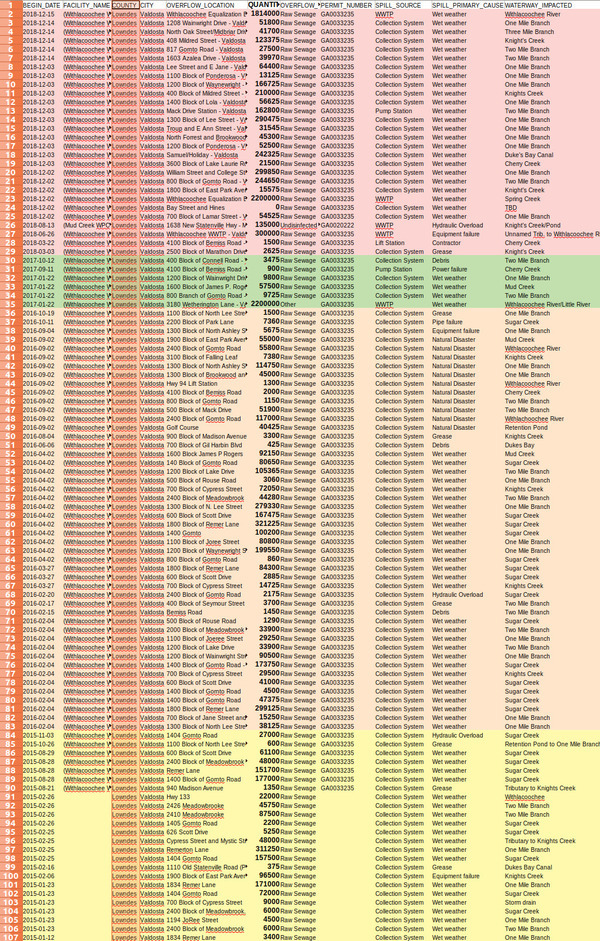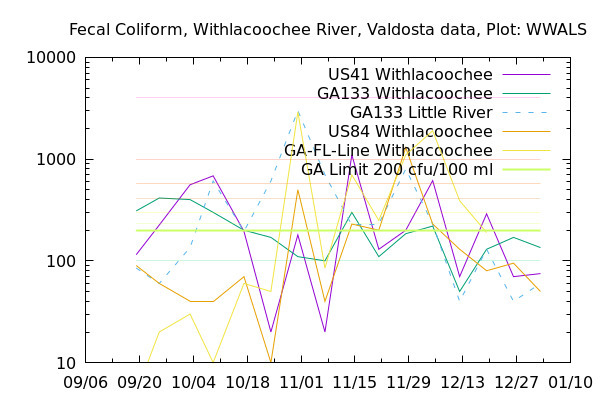Valdosta Utilities naturally painted as rosy a picture as possible, and newspapers have limited space, so here is the rest of the story about Valdosta wastewater at the Suwannee River Water Management District board meeting last Tuesday. SRWMD Chair Virginia H. Johns understands the stigma, and Board Member Virginia Sanchez spelled it out:
“You don’t want to swim in a little sewage versus a lot of sewage either. Both of them are bad. A spill is bad.”
Featured in this post, drawing from the WWALS videos of all the relevant speakers, are Valdosta Utilities Director Darryl Muse, who talked about the catch basin Valdosta is digging, Suwannee Riverkeeper John S. Quarterman, who filled in many pieces omitted by Valdosta and FDEP, and Hamilton County resident Jim McBrayer, who got the attention of the SRWMD board by saying there was E. coli in his well and SRWMD should know where it came from, plus especially the very participatory SRWMD board, who made it pretty clear to FDEP they wanted data by their next meeting, and they wanted Valdosta to move along in fixing their problems in less than a hundred years.
Let’s not forget Merrillee Malwitz-Jipson, who pointed out something Valdosta doesn’t want to hear: it’s the stigma of sewage spills that is the big problem they are causing. For sure we need to find out what the specific health and other effects are of Valdosta sewage and other contamination on river water and nearby wells. But the stigma of Valdosta sewage goes far beyond that.
Darryl Muse, Utilities Director, Valdosta
In the WWALS video,
![[Control Panel Awnings & alarms]](https://www.wwals.net/pictures/2019-02-12--srwmd/shot0011.jpg)
Control Panel Awnings & alarms
in
WWALS video of Valdosta Utilities Director Darryl Muse speaking at SRWMD.
you can hear Darryl Muse talk about something I haven’t heard in any previous public presentation: the new catch basin at the input to Valdosta’s notorious Withlacoochee Wastewater Treatment Plant (WWTP) that Valdosta City Council Tim Carroll told us about via email 6 December 2018.
Director Muse said construction has started on the catch basin.
![[Goals & Objectives: retention pond]](https://www.wwals.net/pictures/2019-02-12--srwmd/shot0014.jpg)
Goals & Objectives: retention pond
His slide about that retention pond was oddly vague:
Construct 1-2 acre (8-10 MG) retention pond for storage of EQ basin overflows
Seriously, they’re digging it and they don’t know how many acres within a factor of two? And why would 8 or 10 million gallons be enough? How did they figure that?
According to a usually reliable source, Valdosta built the new WWTP to handle the same number gallons as went into old WWTP in 2009 during the 700-year flood. But in 2009 that rain fell upstream. In December 2018 it fell on Valdosta. It didn’t occur to them to prepare for that?
The new catch basin should help, but will it be big enough?
And it won’t help with the spills from all the other places.
Speaking of other places, Director Muse said one of their big spills had been of clarifier, not raw sewage, and the press got that wrong. Yes, their big spill back in August from their Mud Creek WTP was of late-stage clarifier, but WALB got that right, as did pretty much all the other press I saw. WWALS even videoed a Mud Creek WTP operative explaining it all.
Also, that Mud Creek WTP spill was 135,000 gallons. See below for what came from the WWTP and many other Valdosta locations in December.
Not just two spills —John S. Quarterman, Suwannee Riverkeeper
Jamie Wachter, Valdosta Daily Times, 2019-02-15, Ongoing Valdosta sewage spills concern Fla. neighbors,
John Quarterman, the Suwannee Riverkeeper and president of the WWALS Watershed Coalition, said while other cities do have spills, Valdosta had more spill locations in December than the rest of the state of Georgia combined, according to data from the Georgia Environmental Protection Division.
See for yourself:
![[Valdosta spills more locations than rest of Georgia]](https://www.wwals.net/pictures/2019-02-18--All-Sewage-Spills-GA-EPD-2015-2018/2018-12-01-03.jpg)
Valdosta spilled more locations than rest of Georgia, December 1-3, 2018.
As you can see, Tifton, Quitman, and Lowndes County also spilled in the Suwannee River Basin in Georgia during those three days, but Valdosta spilled far more than they did.
Because the Florida Department of Environmental Protection (FDEP) started publishing spill reports more than a year ago, we know there have been zero Florida Basin spills reported.
Alabama has also been publishing statewide spills.
Georgia did not publish spills, until the Georgia Environmental Protection Division (GA-EPD) on December 20, 2019. started publishing Sewage Spill Reports each business day, for all of Georgia, for the past thirty days. WWALS collects all these reports on the WWALS website, along with automated differences from the previous day: see wwals.net/issues/vww/ga-spills/.
This happened because twenty organizations in Georgia and Florida signed a resolution WWALS started, asking GA-EPD to publish spill reports, before WWALS sent that resolution to GA-EPD on November 1, 2018, to a positive response the next day. More organizations signed, totaling 31, until we were all astonished at the early Christmas present when GA-EPD started doing it. For more about how that happened and what needs to be done now, see my recent talk and my slides.
As the VDT reported:
“Valdosta, being the largest city in the entire Suwannee River basin by far, it also has the largest responsibility to fix its problems,” Quarterman said.
![[Movie: Spills and Testing --John S. Quarterman, WWALS (211M)]](https://www.wwals.net/pictures/2019-02-12--srwmd/7jsq.jpg)
Movie: Spills and Testing –John S. Quarterman, WWALS (211M); see WWALS video.
Many of the SRWMD board nodded at that point. The lack of Florida spills is not due to some superior virtue of Florida cities. It’s simply because even the largest, Lake City, has a fifth of the population of Valdosta. The second largest city in the Suwannee River Basin, Tifton, GA, also has the second most spills. (The third, Moultrie, also spills, but usually from its west side into the Ochlocokonee River Basin.)
Larger cities and towns in the Suwannee River Basin,
with (recent population numbers)
- Georgia: Adel (5,270), Argyle (213), Ashburn (3,897), Barwick (378), Cecil (278), Chula (unknown), Dasher (956), DuPont (123), Fargo (324), Fitzgerald (9,048), Hahira (2,846), Homerville (2,452), Lakeland (3,391), Lake Park (750), Moultrie (14,506), Morven (532), Nashville (4,986), Naylor (122), Norman Park (976), Ocilla (3,538), Omega (1,251), Quitman (3,664), Ray City (1,058), Remerton (1,151), Sparks (2,003), Statenville (unknown), Sylvester (6,283), Tifton (16,672), Valdosta (57,597)
- Florida: Bell (454), Branford (723), Cedar Key (698), Chiefland (2,206), Cross City (1,692), Fanning Springs (974), Horseshoe Beach (167), Lake City (12,100), Lee (330), Live Oak (6,919), Luraville (?), Mayo (1,251), Jasper (4,452), Jennings (866), Madison (2,769), Old Town (j?), Suwannee (?), Trenton (2,023), White Springs (776).
Sure, Gainesville Regional Utilities (GRU) often reports spills, but even though Gainesville, Florida, has twice the population of Valdosta, Georgia, Gainesville is not in the Suwannee River Basin.
We all appreciate the millions of dollars Valdosta has already spent in Sanitary Sewer System Improvements and the additional half million the Valdosta City Council approved December 6, 2018.

Ten lift station generators and a SCADA system approved by Valdosta City Council 2018-12-06
But here’s another reason Valdosta has more responsibility. Many of Valdosta’s sewage fixes, probably including those approved in December, are paid for by a penny sales tax, the Special Local Option Sales Tax (SPLOST).
Elected and appointed officials of Lowndes County and Valdosta often brag that:
“The experts say 50.2% of the sales tax is paid by out of towners.”
Many of those out of town shoppers in Valdosta come from north Florida. Wouldn’t this tax collection from people downstream indicate still more responsibility for Valdosta to fix its sewage problems that affect many of those same people?
Because of the GA-EPD spill reports, now we can see how Valdosta compares.

This early WWALS map doesn’t even show all those early December Valdosta spills, because they weren’t all reported yet.
Valdosta spilled not just those two big times at the WWTP. It also spilled two dozen other places in December Valdosta did not tell the public about. We know about them because of the GA-EPD data. Valdosta chronically spills far more than the rest of the Suwannee River Basin.

Valdosta December 2018 sewage and Hamilton County, FL legislative delegation 2019-01-16.
For example, at 1208 Wainwright Drive, Valdosta spilled 166,275 gallons December 3, 2018 and 51,800 gallons December 14, for 218,075 gallons of raw sewage in December, 2018. Valdosta has had large, repeated sewage spills there, directly into One Mile Branch, then Sugar Creek, then into the Withlacoochee River.
![[Lime and broken concrete down to One Mile Branch]](https://www.wwals.net/pictures/2019-02-10--wq-testing-one-mile-branch/20190210_171844.jpg)
Lime and broken concrete down to One Mile Branch at 1208 Wainwright Drive, Valdosta, GA.
That is a more direct path to the Withlacoochee River than the WWTP spills, about 2 and a quarter miles, but all by water, while the WWTP is a mile uphill from the river.
Also note that all of the 6,273,595 gallons Valdosta spilled in December were raw sewage, not clarifier, so Director Muse’s discussion of the Mud Creek WTP clarifier spill, which was 135,000 gallons of clarifier, is rather beside the point. The December 3 spill alone at 1208 Wainwright Drive was more than that.
And notice that 6,273,595 minus the 4,014,000 gallons from the WWTP, leaves 2,259,595 gallons of raw sewage spilled from those other two dozen locations in December 2018. Adding a WWTP catch basin is a good idea. But it won’t solve all of Valdosta’s sewage problems.
I used to at least be able to say the situation was improving in Valdosta. But Valdosta spilled more gallons of raw sewage and from more places in December, 2018, than in all of 2017.

Sewage spills in the Suwannee River Basin 2015-2018.
SRWMD Board
A SRWMD board member wanted to know how Valdosta’s spills compared to the rest of Georgia.
![[Movie: Public Comments --Chair (32M)]](https://www.wwals.net/pictures/2019-02-12--srwmd/7public.jpg)
Movie: Public Comments –Chair (32M)
Here are all the spills reported to GA-EPD in the calendar years 2015 to 2018:
E. coli in Jim McBrayer’s well and the need for testing
As the VDT wrote, and as you can see the WWALS video:
Moving to the area three years ago, Jim McBrayer had his well near the Suwannee River in Hamilton County tested.
It came back positive for E. coli, leading McBrayer to have a water infiltration system installed.
He said filtration. Infiltration is what’s happening to Valdosta’s wastewater system: stormwater from rainfall is infiltrating into the sewers, producing overflows.
That system failed following a wastewater spill from the City of Valdosta just a week later.
Jim McBrayer’s place at 7354 143 CR SW in Hamilton County is more than a mile from the Withlacoochee River, according to the Hamilton County Property Appraiser’s map. If Valdosta sewage is getting that far inland through the fragile karst limestone containing our drinking water, it may be affecting many other wells as well, making this a huge problem.
After replacing it with another system, McBrayer wasn’t in the mood to hear a Suwannee River Water Management District board member ask a Valdosta representative at a Feb. 12 board meeting just how bad the spills are.
“This is totally unacceptable,” McBrayer said. “When someone on this board is asking how bad is it. That’s unacceptable to me. You guys need to know how bad it is. You’re representing us. You’re the party that protects us from this kind of situation.
“I’m sorry to do that. When I was in the Army, I had responsibility to fix (problems). I would hope you’d do the same.”
Testing
Part of the issue the board and McBrayer were responding to was my point that Valdosta’s own weekly water quality test data shows that bacterial contamination often gets into the river when there are no spills, and often upstream of the WWTP.

Still below the limit: fecal coliform in Valdosta river data 2019-01-02.
The graph above shows the recent holiday season clean on the Withlacoochee River, but September, October, and November were frequently above the 200 CFU/100 ml Georgia state limit, and sometimes well above the 1,000 serious warning line. Not only that, these high readings often occurred at US 41 (North Valdosta Road) upstream of the WWTP and of most of Valdosta, or at the state line while readings at US 84 between the WWTP and Florida were clean.
That Valdosta data has shown things are getting into the rivers when there are no spills. It could be coming from wildlife, cows, horses, pigs, septic tanks, cats, dogs, or other. E. coli can get into peoples’ wells from those, too. We need to find out when and what and see what can be done.
Not to mention we need to know how far downstream Valdosta’s spills go, and for how long.
Director Muse first told SRWMD Valdosta’s test data was publicly available, and then said it wasn’t. So I told them that it is publicly available on the WWALS website, here: wwals.net/issues/testing/ This is possible because WWALS has been filing weekly open records requests with Valdosta to get the data and publishing the results.
Unfortunately, Valdosta has decided to decrease their testing from weekly to only monthly.
As I said to SRWMD, and as I have indicated in in the Gainesville Sun, the Lake City Reporter, the Columbia County Observer, and the Valdosta Daily Times, I have asked GA-EPD to require Valdosta to resume testing weekly, and to post that data themselves on their own website.
WWALS has started a volunteer water quality monitoring program, for that see the same web page: wwals.net/issues/testing/
![[Want the brown flakes to dissolve]](https://www.wwals.net/pictures/2019-01-06--wwals-troupville-testing/20190106_154612.jpg)
Want the brown flakes to dissolve: Sara Jay testing at Troupville Boat Ramp 2019-01-06.
We of WWALS do what we can. But it seems absurd to expect a tiny volunteer nonprofit to handle testing for the 10,000 square mile Suwannee River Basin, when state funding by Georgia and Florida would be a drop in the bucket compared to the cost of one sewer line replacement.
In the SRWMD meeting, after I pointed it out, Bob Vincent of FDEP agreed that FDEP currently only tests downstream of the state line the week after a spill: not before, and not after. So there are no baselines.
![[Movie: E. coli --Bob Vincent, FL Dept. Health & others (488M)]](https://www.wwals.net/pictures/2019-02-12--srwmd/7vincent.jpg)
Movie: E. coli –Bob Vincent, FL Dept. Health & others (488M)
Various SRWMD and other experts discussed what to test.
![[Movie: What to test --John Thomas, MMJ, Tom Mirti, jsq, others (246M)]](https://www.wwals.net/pictures/2019-02-12--srwmd/7mirti.jpg)
Movie: What to test –John Thomas, MMJ, Tom Mirti, jsq, others (246M)
Don’t get me wrong: I’m not criticizing the individuals with FDEP and SRWMD who discussed this. They can only do what they are directed and funded to do. Similary for Valdosta Utilities Director Darryl Muse and his predecessor Henry Hicks. They did not create this situation. Muse is trying to fix it, and Hicks presided over much of the Sewer System Improvements already in place.

Utilities Director Henry Hicks and other Valdosta elected and appointed officials meeting with WWALS 2015-03-17.
Yet more testing and fixes need to be funded and directed.
Fortunately, the SRWMD board seemed to take the ball on this one. As Jim Tatum pointed out for OSFR, 2019-02-15, Marathon Meeting at SRWMD,
Board member Virginia Sanchez asked some hard questions, for which there were no satisfying answers. Interestingly, she called out the Valdosta plan which, if carried out, would take a hundred or more years, or at least a number rendering it totally impractical.
When I stood up first to speak, the Chair, Virginia H. Johns, couldn’t get my name right. During the break after the lengthy Valdosta discussion, she made a point of asking me to come back next month, when there would be test results.
I hope she means regular Florida testing, weekly, stateline and down, not just the one week after a spill, and not just this one month.
Things to test for:
-
E. coli as an indicator test
Need followups for toxic forms of E. coli -
Fecal coliform
high levels should trigger test for pathogens - Sucralose, which is a marker for sewage (thanks, Merrillee)
- Nitrates: fertilizer runoff leachates, related to BMAPs
- And the usual pH, temperature, etc.
Darryl Muse claims “the science” says Valdosta can’t be causing problems such as E. coli in Jim McBrayer’s well. I guess by that he means Valdosta’s own water quality testing. First, that needs independent third-party validation, and FDEP testing only for one week is not that validation. Second, FDEP and the Hamilton County Health Department say they have found correlation between well contamination and Valdosta’s spills. So we need more testing to find out whether there is a connection.
And whether it’s Valdosta’s spills or something else getting into river water and into wells, don’t we want to know what, when, and where it is, so we can find it and do something about it?
Paddles
I also invited SRWMD and other people in the room to Paddle Georgia, with 300 of our closest friends, for a week on the Withlacoochee and Suwannee Rivers, starting June 15, 2019 at Troupville Boat Ramp, just west of Valdosta, and ending up June 21, 2019 at the Hal W. Adams Bridge Boat Ramp, in Lafayette County, Florida.
![[Days]](https://www.wwals.net/pictures/2019-02-13--paddle-georgia-pr/daymap.jpg)
Days
Detail from
interactive
google map by WWALS of the
Journey Details.
In the meeting I said Suwannee County, and this takeout is right across the bridge and former ferry site from Luraville, Florida, hometown of my grandmother, in Suwannee County. The Final Feast, which WWALS is catering on Friday, June 21, 2019, will be at Camp Suwannee, in Advent Christian Village, Dowling Park, Suwannee County, Florida.
All those boaters from Georgia and Florida and beyond will be paddling right by the outflow from Valdosta’s Mayor John Gayle Memorial Withlacoochee Wastewater Treatment Plant. That got a laugh and a mention later.
I did get some advice to omit the word “Memorial”, which is usually used for deceased persons. As you can see Mayor Gayle is alive and speaking:

Lowndes County Chairman Bill Slaughter, Valdosta Mayor John Gayle, at the Bird Supper, Atlanta, 2019-02-16; photo John S. Quarterman for WWALS.
This was at the Bird Supper, in which Lowndes County and Valdosta feed Georgia state legislators quail at the Railroad Freight Depot in Atlanta. I invited SRWMD to that event; none of them attended on such short notice. At the Bird Supper, I took the opportunity to be the first to mention this name to Valdosta Mayor John Gayle. Mayor Gayle said he was fine with that name, because he is proud of that plant, which itself did not fail, so here’s that name again: the Mayor John Gayle Withlacoochee Wastewater Treatment Plant.
At the SRWMD meeting, I also advised that the Sabal Trail fracked methane pipeline already leaked at its Hildreth Compressor Station in Suwannee County, back in September, and that neither FERC nor PHMSA had done anything about that. Plus Sabal Trail has now added an interconnection with Florida Gas Transmission (FGT), also in Suwannee County, adding to the risk.
And BMAPS are a different, but much bigger problem. Yay to all those who are working on the Valdosta and other sewage problem. But fertilizer nitrates leaching into our springs and rivers is actually a much bigger problem and people should be working on that, too.
This is the short version of that SRWMD meeting. You can see the rest for yourself in the WWALS videos.
-jsq, John S. Quarterman, Suwannee RIVERKEEPER®
You can join this fun and work by becoming a WWALS member today!
Short Link:



![[Sign and pipe]](https://www.wwals.net/pictures/2019-02-03--troupville-spook-outing/wwtp.jpg)